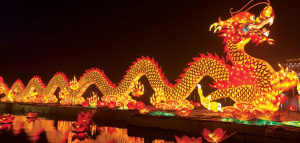Language/Mandarin-chinese/Culture/Chinese-New-Year
你好 Chinese Learners! 😃
➡ In today's lesson you will find out what's going on during the 8 days of the Chinese New Year.
Although the first day is the culmination of the holiday, the Chinese New Year takes place over 8 days.
Each day corresponds to a symbolism and a tradition:
After you've delved into this material, you may find these associated topics worth exploring: Internet resources for learning Mandarin ..., China Timeline, Dragon Boat Festival and Zongzi & Spring Festival and Chunyun.
The first day of Chinese New Year[edit | edit source]
The first day of the Chinese New Year is "the day of the rooster", this first day marks the official beginning of the holidays of the Chinese New Year or Asian New Year. This first day is also called "the beginning of the first morning".
This first day gives rise to a very noisy and colorful cavalcade in the streets of the city. The lion and the dragon begin a furious dance in the streets and to chase the bad spirits, this dance is accompanied by a deafening din of drums and gongs.
The firecrackers are not left out, they are whole bunches of firecrackers that are lit all along the parade route.
The dragon and lion dance is accompanied by numerous demonstrations of martial arts or dance fights.
The party is launched for eight days, but the festivities will not really end until 15 days later, the day of the lanterns.
The second day of Chinese New Year[edit | edit source]
The second day is called the "dog day" or "the reception of the son-in-law" traditionally, it is the day when the family goes to the parents of the wife to pray to the God of fortune and ask him protection for the new year.
The meal is still vegetarian.
The third day of Chinese New Year[edit | edit source]
The third day of the Chinese New Year is called the "piggy day" or "the wedding of the mouse".
According to custom, one must prepare offerings for the mice that live in the house. It is a way to appease the wrath of the deity "mouse-eared girl" who was offended by a coalman.
The fourth day of Chinese New Year[edit | edit source]
The fourth day is called the "day of the sheep". This day is very important because it marks the return of the gods within the home. They are welcomed by many offerings of the inhabitants of the home.
The fifth day of Chinese New Year[edit | edit source]
The fifth day is called "beef day", it gives the signal for the end of the festivities. This is the day when we put away the New Year's decorations.
The sixth day of Chinese New Year[edit | edit source]
The sixth day is called the "day of the horse".
The seventh day of the Chinese New Year[edit | edit source]
The seventh day is called the "day of the laughing man", it is dedicated to longevity. A big meal brings the family together to pray for the longevity of all.
The day of lanterns late Chinese New Year[edit | edit source]
The fifteenth day is called "lantern day", it marks the end of the Chinese New Year festivities. The day of lanterns is the festival of light.
The inhabitants parade through the streets at nightfall carrying a round lantern decorated with icons of signs of the Zodiac.
The end of the party is marked by fireworks and tasting treats. Today, the children parade at night with a lantern in their hands.
Chinese lanterns[edit | edit source]
The traditional Chinese New Year lanterns are made of paper and are decorated with drawings referring to Chinese mythology and traditions or drawings of animals or plants.
The traditional lanterns in paper and candle are released and rise in the sky in a magnificent ballet of light.
Today, traditional lanterns are increasingly replaced by plastic lanterns. More and more lanterns represent the heroes of cartoons or movies watched by children.
Modern characters are gradually replacing traditional motifs. A bit like the Mexican pinata, the lanterns lose their traditional character.
Other Lessons[edit | edit source]
- Chronology of Historical Events in China
- Kung Fu
- Internet resources for learning Mandarin Chinese
- History
- Translations of Skyrim
- Why Learn Chinese Mandarin
- China Timeline


